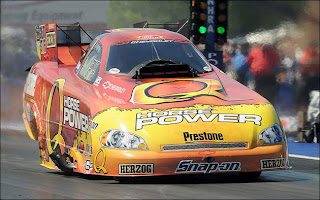NHRA’s Quarter Mile is Now 1,000 Feet Instead of 1,320
By Chris Haak
07.03.2008
 The National Hot Rod Association (NHRA) announced late yesterday that in the wake of the recent tragic death of popular Funny Car driver Scott Kalitta on June 21, it is immediately shortening its race distance by 320 feet to 1,000 feet for its Top Fuel and Funny Car classes. The change goes into effect next weekend at the Mopar Mile High Nationals in Denver (July 11-13).
The National Hot Rod Association (NHRA) announced late yesterday that in the wake of the recent tragic death of popular Funny Car driver Scott Kalitta on June 21, it is immediately shortening its race distance by 320 feet to 1,000 feet for its Top Fuel and Funny Car classes. The change goes into effect next weekend at the Mopar Mile High Nationals in Denver (July 11-13).
Kalitta’s crash occurred after his car’s engine exploded and the car continued to the end of the track, through a sand pit, and finally stopped when it hit a wall. The car’s parachutes did not deploy. Similar to how Dale Earnhardt’s death at the end of the 2001 Daytona 500 spurred NASCAR to take dramatic steps to improve driver safety (which culminated in the ugly, but apparently safer, Car of Tomorrow that all teams must now use), Kalitta’s death appears to have encouraged the NHRA to immediately take safety concerns more seriously.
The NHRA announced that effective immediately, it is looking into the following issues while it investigates Kalitta’s fatal crash:
– how to reduce engine failures
– parachute mounting techniques and materials
– increased braking efficiency when downforce is lost due to the car body being lost
– new ways to stop runaway vehicles at the end of the track
– considering the need to reduce speeds for more safety.
The most dramatic change, though, was the reduction of the race length. The quarter mile is obviously the most identifiable racing statistic for straight-line acceleration. No longer timing the final 320 feet of the quarter mile will of course render records and comparisons meaningless. Obviously, both elapsed times and trap speeds will be lower (since the cars have to cover a shorter distance before the end of the track, and since the cars will not have the full track length to accelerate). However, the safety benefit is the addition of an additional 320 feet – about the length of a football field – in runoff area at the end of the track.
Some drivers had complained that the runoff area at the Englishtown, NJ speedway where Kalitta’s crash occurred was not long enough. The NHRA said that the change was made in collaboration with race teams.
Many of the other safety initiatives that the NHRA is investigating have already been implemented in other race series; NASCAR’s superspeedways that require restrictor plates to reduce engine power are a direct result of the same goal of reducing speeds. The roof flaps that pop up in NASCAR race cars when the car is about to go airborne, and they keep the car on the ground and hopefully slow it down enough for the driver to regain control.
I’m not really an ardent fan of auto racing, although I am something of a purist when it comes to traditional aspects of any sport. Although I can see why the NHRA has made this change, to me it almost feels like Major League Baseball announcing that next season, the distance between the bases will go from 90 feet to 75 feet to reduce the risk of injuries. Hopefully, the safety for drivers can be enhanced, and better/longer runoff areas can be added to all racetracks so that they can return to the traditional quarter mile length for the fastest cars.
My father was a successful amateur drag racer in the 1960s and early 1970s; although we haven’t spoken about this news yet, the concept of a 1,000 foot drag race is probably pretty foreign to him, and to many fans of the sport.
COPYRIGHT Full Metal Autos – All Rights Reserved




